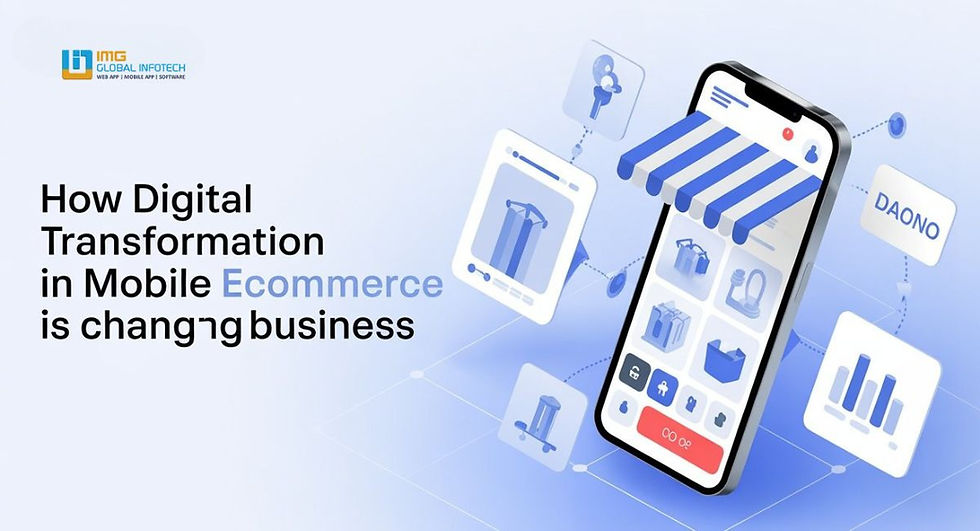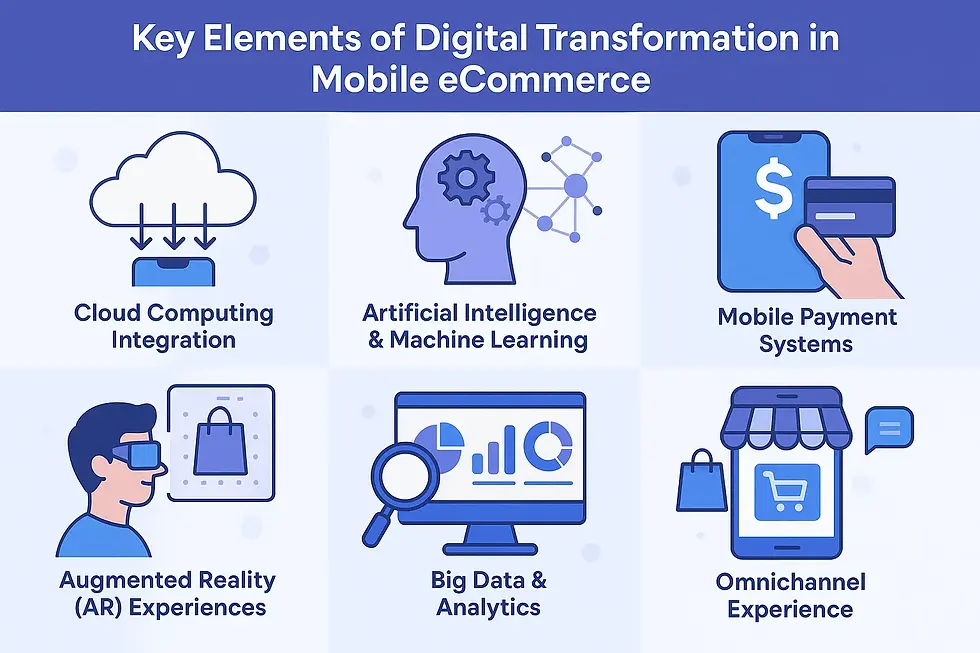How Digital Transformation in Mobile eCommerce Is Changing Business
- Ramesh Kumawat
- Jul 18
- 6 min read

In today’s fast-paced digital world, mobile eCommerce is no longer a trend—it’s a business imperative. As mobile devices dominate daily life, the fusion of digital transformation and mobile eCommerce is reshaping how businesses operate, engage customers, and compete in global markets. This transformation is not merely about building an app or creating a responsive website—it’s about a complete overhaul in the way companies think, function, and deliver value.
From cloud integration to AI, from real-time engagement to personalized customer experiences, mobile eCommerce is at the core of the digital revolution. This article explores how digital transformation in mobile eCommerce is changing the face of modern business and what it means for future growth.
The Rise of Mobile eCommerce
The global shift toward mobile commerce (mCommerce) has been phenomenal. With the number of smartphone users worldwide expected to surpass 7.7 billion by 2027, businesses are experiencing a mobile-first consumer wave. According to Statista, mobile commerce sales are projected to account for over 73% of total eCommerce sales by 2025.
This shift is not just due to technological accessibility but also to changing consumer behaviors. Shoppers prefer the convenience of mobile apps and websites that allow browsing, purchasing, and payment—all from the palm of their hand. Whether it’s ordering groceries, booking travel, or shopping for fashion, mobile eCommerce offers unparalleled ease and speed.
Key Elements of Digital Transformation in Mobile eCommerce

1. Cloud Computing Integration
Cloud technology has become the backbone of digital transformation in mobile eCommerce. Businesses now leverage cloud platforms for:
Scalability – easily managing large traffic surges during sales or festive seasons.
Storage – housing massive product databases, media files, and user information.
Global reach – serving international customers without relying on physical infrastructure.
Cloud infrastructure also allows businesses to update features instantly, reducing downtime and ensuring users always have access to the latest version of the app or mobile site.
2. Artificial Intelligence & Machine Learning
AI and ML are revolutionizing how mobile eCommerce functions. Through predictive analytics and behavior tracking, businesses can:
Provide personalized recommendations based on browsing and purchase history.
Enable smart chatbots for real-time customer support.
Use automated inventory and demand forecasting systems.
AI allows companies to cater to each customer’s preferences and buying journey, creating a more engaging and converting experience.
3. Mobile Payment Systems
Gone are the days when entering credit card details was a tedious task. With the integration of digital wallets like Apple Pay, Google Pay, Paytm, and UPI systems, payments have become:
Faster
Secure
Frictionless
The rise in one-click checkouts and biometric authentication (fingerprint, face ID) ensures that purchases happen with minimal interruption.
4. Augmented Reality (AR) Experiences
AR is reshaping mobile eCommerce by enabling users to visualize products in real-life environments before purchase. From virtual try-ons for clothes and makeup to placing furniture virtually in your room, AR boosts:
Customer confidence
Reduced returns
Stronger engagement
For example, IKEA’s app allows customers to see how furniture would look in their homes using AR features.
5. Big Data & Analytics
With digital transformation, businesses now have access to vast amounts of customer data from mobile interactions. Big Data helps in:
Understanding customer behavior patterns
Creating segmented marketing strategies
Improving product recommendation engines
Analytics tools integrated into mobile platforms enable real-time performance tracking, customer lifetime value analysis, and campaign optimization.
6. Omnichannel Experience
A significant shift is the demand for a seamless omnichannel experience. Users expect their journey to flow smoothly across:
Mobile apps
Websites
Physical stores
Social media platforms
Digital transformation bridges these platforms, ensuring consistent product info, customer support, and order status across all touchpoints.
How Businesses Are Evolving Through Mobile eCommerce
1. Faster and Personalized User Experience
Modern mobile apps are optimized for speed, performance, and personalized engagement. Brands are investing in UI/UX design to ensure:
Quick navigation
Minimal clicks to purchase
Customization options
Personalization—such as showing recently viewed items, birthday offers, and dynamic pricing—significantly increases user loyalty.
2. Agile Business Models
Digital transformation promotes flexible business models like:
Subscription-based (e.g., beauty boxes, meal kits)
On-demand services (e.g., food delivery, cab services)
Direct-to-Consumer (D2C) models bypassing retailers
These models flourish due to the low operational cost and high scalability of mobile platforms.
3. Real-Time Customer Engagement
Real-time communication tools such as:
Push notifications
In-app messaging
Live chat support
...have changed how businesses interact with users. Now, companies can engage customers instantly with updates, offers, and support, leading to improved conversion rates.
This is where Real-Time Features in Mobile App experiences play a game-changing role. They enable dynamic personalization, quick updates, and uninterrupted shopping interactions.
4. Increased Operational Efficiency
Automation in mobile eCommerce processes helps businesses:
Track inventory in real-time
Streamline shipping logistics
Automate repetitive tasks such as email confirmations and invoice generation
This reduces human error and allows employees to focus on high-value tasks.
5. Data-Driven Marketing Strategies
Mobile eCommerce platforms collect data that allows for:
Hyper-targeted campaigns
Dynamic pricing strategies
A/B testing of product layouts and offers
These insights translate into higher ROI for marketing spends and better customer engagement.
Benefits of Embracing Mobile Digital Transformation
Enhanced Customer Retention: Personalized experiences and instant support lead to repeat purchases.
Higher Conversion Rates: Smooth mobile interfaces reduce cart abandonment.
Global Accessibility: Businesses can reach international audiences without physical stores.
Scalability: Rapid growth without proportional increases in cost or infrastructure.
Competitive Advantage: Brands that adopt mobile-first strategies gain an edge in saturated markets.
For instance, if you aim to Build a Marketplace Mobile App, embracing these transformation tools ensures a scalable, user-centric platform that meets evolving consumer expectations.
Challenges in the Transformation Process
While the benefits are significant, businesses must overcome several challenges:
1. Security & Data Privacy
Handling sensitive customer data comes with risks. Ensuring secure payment gateways and complying with data privacy laws (e.g., GDPR, CCPA) is critical.
2. Integration With Legacy Systems
Many companies face hurdles integrating modern mobile tech with their outdated infrastructure.
3. High Upfront Costs
Developing feature-rich mobile apps with AI, AR, and payment integrations requires considerable investment.
4. Continuous Updates
Mobile eCommerce platforms demand ongoing maintenance and feature upgrades to meet user expectations and platform requirements (iOS, Android updates).
Real-World Examples
Amazon
Amazon leads the digital transformation game with features like:
Voice-enabled Alexa shopping
One-click mobile checkout
Personalized mobile dashboards
Nike
Nike’s app provides:
AR-based shoe try-ons
In-app workout programs
Real-time inventory updates for nearby stores
Nykaa (India)
Nykaa, a beauty eCommerce app, integrates:
Virtual makeup try-on
Product videos
AI-based beauty recommendations
These features are powered by digital transformation efforts that enhance mobile experiences and demonstrate key lessons from Mobile App Development 101—focusing on performance, usability, and customer engagement.
Future Trends in Mobile eCommerce Transformation
Voice Commerce
Shopping via voice assistants like Siri, Alexa, and Google Assistant.
AI-Powered Virtual Shopping Assistants
Personalized conversational bots that mimic human interaction.
Blockchain Integration
Enhancing transaction security and product traceability.
Sustainability Focus
Eco-conscious mobile platforms showing carbon impact, ethical sourcing, etc.
Progressive Web Apps (PWA)
Offering app-like experiences via mobile browsers, reducing the need for app downloads.
Companies seeking to ride this wave are increasingly partnering with firms offering App Development Services in Jaipur, combining regional innovation with global market readiness.
Conclusion
Digital transformation in mobile eCommerce is not a future concept—it’s the present reality reshaping every industry. Businesses adopting mobile-first strategies powered by AI, cloud, real-time analytics, and seamless interfaces are witnessing enhanced customer loyalty, operational efficiency, and exponential growth.
For organizations looking to stay relevant, competitive, and profitable, embracing mobile digital transformation is not optional—it’s essential.
FAQs
Q1. What is digital transformation in mobile eCommerce? Digital transformation in mobile eCommerce refers to integrating digital technologies like AI, cloud, and mobile interfaces to improve customer experience, streamline operations, and drive business growth.
Q2. How does AI impact mobile eCommerce? AI enables personalized shopping experiences, intelligent chatbots, predictive analytics, and automation in customer service and product recommendations.
Q3. Why is mobile optimization critical for eCommerce businesses? Most consumers shop via smartphones. A mobile-optimized experience ensures fast load times, smooth navigation, and higher conversion rates.
Q4. What are some common challenges of mobile digital transformation? Security issues, integration with legacy systems, high upfront costs, and the need for ongoing updates are major challenges businesses face.
Q5. How does AR improve mobile shopping? AR lets customers virtually try products before buying, improving confidence, reducing returns, and enhancing engagement.
Q6. What are some future trends in mobile eCommerce? Voice commerce, blockchain, sustainable apps, AI-driven personal assistants, and Progressive Web Apps are expected to lead the next wave of digital evolution.




Comments